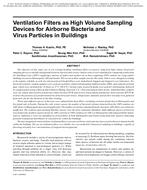Description
The objective of this study was to use existing building ventilation filters as passive, long-term high volume bioaerosol sampling devices to identify background airborne bacteria and viruses. Indoor sources were identified by comparing results from Air Handling Units (AHUs) supplying a mixture of indoor and outdoor air to those supplying 100% outdoor air. Large public buildings located in Minneapolis, MN and Seattle, WA served as filter sample sites for this study. Filters were changed according to the regular schedule at each site and preselected loaded filters were immediately bagged and shipped to our laboratory. For bacterial isolation, random samples were cut from each filter, eluted with phosphate buffered saline (PBS), and cultured on blood agar, which were incubated for 24 hours at 37°C (98.6°F). Various types of growth media were used for subculturing, followed by categorization using a BioLog MicroStation (Biolog, Hayward, CA, USA) and manual observation. Additional filter samples were cut, eluted, and tested by polymerase chain reaction (PCR) and reverse transcription polymerase chain reaction (RT-PCR) to detect the presence of a predetermined list of bacteria and viruses. Temperature, humidity and air flow rate data were gathered from each site for the duration of the filter loading.
Thirty-nine different species of bacteria were cultured from these filters, including seventeen found only in Minneapolis and five found only in Seattle. During the cold, winter season, the number of bacterial colonies detected from the 100% outdoor air AHU filters in Minneapolis decreased significantly. The number of colonies obtained from the mixed air AHU filters was relatively unaffected. The resilient spore-forming Bacillus species were the most commonly identified. Eight different species of bacteria were found only on filters used in mixed air AHUs and not in 100% outdoor air AHUs in Minneapolis indicating probable indoor sources. Influenza A virus was identified on several filters in both Minneapolis and Seattle using molecular analysis indicating potential widespread distribution of viral particles within the buildings.
The microorganisms removed from ventilation filters were once airborne, and some may have posed a threat to human health within the building. The use of ventilation filters is a reliable, low cost method for bioaerosol sampling in buildings; capable of detecting extremely low concentrations of targeted microorganisms.
Citation: IAQ Conference: IAQ 2010: Airborne Infection Control
Product Details
- Published:
- 2011
- Number of Pages:
- 7
- File Size:
- 1 file , 560 KB
- Product Code(s):
- D-IAQ2010-C96




